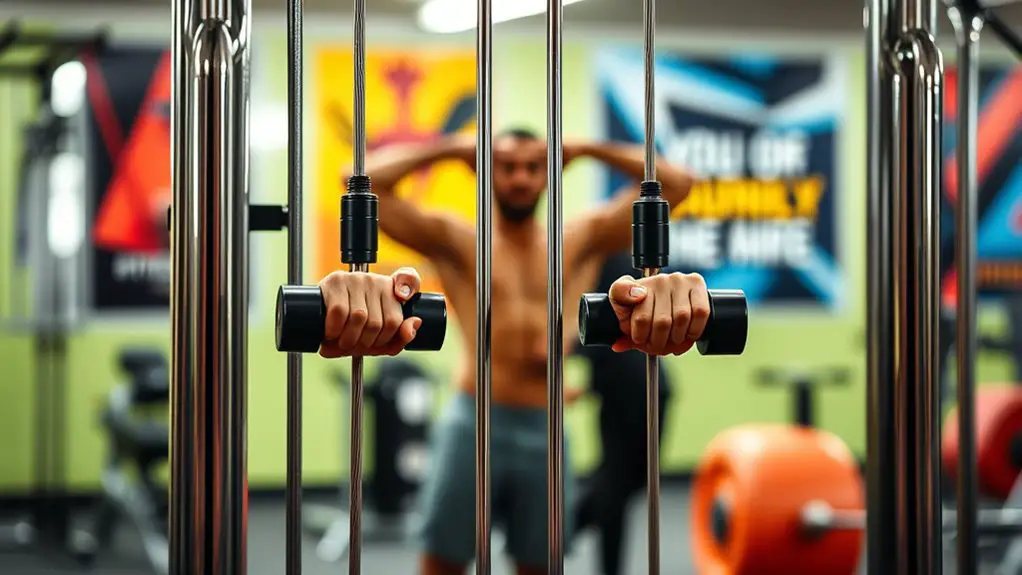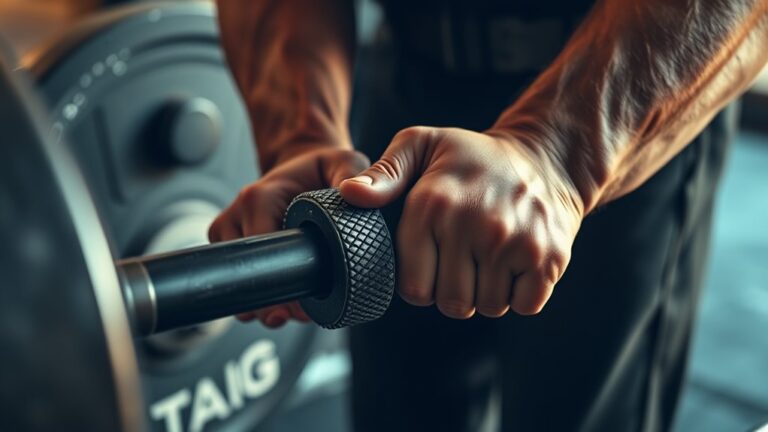How to Maximize Your Workouts on a Cable Machine

To maximize your workouts on a cable machine, focus on mastering proper form and technique. Incorporate a variety of exercises that target all major muscle groups, like cable rows and chest presses. Maintain a stable posture with a shoulder-width stance and engage your core to avoid injury. Gradually increase resistance as you get comfortable. Aim for balanced training with 2-3 sessions per week, ensuring effective muscle engagement. There’s a lot more to explore to enhance your cable workouts further.
Understanding the Basics of Cable Machines

When you think about strength training, cable machines might not be the first equipment that comes to mind, but they offer a versatile way to enhance your workouts. Understanding cable machine anatomy is crucial for safe and effective use. These machines typically consist of a sturdy frame, adjustable pulleys, and a weight stack, allowing you to perform various exercises targeting different muscle groups.
Cable resistance types include both adjustable weights and resistance bands, giving you the flexibility to customize your workout intensity. This adaptability can help minimize the risk of injury, as you can gradually increase resistance according to your fitness level.
Always verify the machine is correctly set up before starting, and maintain a stable posture while exercising to keep your movements controlled. By familiarizing yourself with cable machine anatomy and resistance types, you’ll be better equipped to utilize this valuable tool safely and effectively in your training regimen.
Key Benefits of Cable Training
When you choose cable training, you access a world of versatile exercise options that can target different muscle groups. This approach not only improves muscle activation but also enhances joint stability, making your workouts safer and more effective. Let’s explore how these benefits can elevate your fitness routine.
Versatile Exercise Options
Cable training offers an impressive variety of exercise options that can cater to nearly every fitness goal. With cable machine variations, you can easily adjust the weight and angles, ensuring a safe and effective workout. This versatility allows you to target specific muscle groups while minimizing the risk of injury. You can create creative combinations of exercises, such as cable rows, chest presses, or lateral raises, all while maintaining proper form. By incorporating different grips and stances, you’ll keep your workouts fresh and engaging. Plus, the stability offered by the cable machine helps you focus on your movements without worrying about balance. Embrace this versatility to enhance your training routine and achieve your fitness objectives safely.
Improved Muscle Activation
One of the standout benefits of cable training is its ability to enhance muscle activation. When you use a cable machine, you can achieve greater muscle recruitment by adjusting the cable’s position and resistance. This allows you to target specific muscles more effectively than traditional free weights. With proper tension control, you can maintain consistent resistance throughout your movement, which helps to engage more muscle fibers. This not only improves your strength gains but also reduces the risk of injury since you can focus on form and alignment. By incorporating cable exercises into your routine, you’ll notice better muscle engagement, leading to more effective workouts and improved overall performance. Prioritizing muscle activation will keep you safe and help you reach your fitness goals.
Enhanced Joint Stability
Improved muscle activation through cable training also contributes to enhanced joint stability. When you engage in stability training with cable machines, you’re promoting better joint alignment, which is fundamental for injury prevention. This type of training encourages your stabilizing muscles to work harder, providing support to your joints during movements. By maintaining proper alignment, you’ll reduce the risk of strain and enhance overall performance.
Incorporating cable exercises into your routine not only builds strength but also improves coordination, ensuring your body moves more efficiently. As you strengthen these stabilizing muscles, you’ll notice increased control and balance during workouts and daily activities. Prioritizing joint stability is essential for long-term fitness success and safety, so make cable training a critical part of your regimen.
Essential Cable Machine Exercises for Beginners
When you’re starting out with a cable machine, focusing on fundamental movements is key to building strength. These exercises can effectively target major muscle groups, helping you create a balanced workout routine. Plus, mastering proper form techniques will guarantee you get the most out of each session while reducing the risk of injury.
Fundamental Cable Movements
Cable machines are versatile tools that can enhance your workouts with a variety of effective exercises. For beginners, focusing on fundamental cable movements is key to building a solid foundation while ensuring safety. Start with basic cable variations, like the cable row and cable press, which promote essential movement patterns. These exercises engage multiple muscle groups and help improve your stability and strength. Always adjust the weight to something manageable, allowing you to maintain proper form. It’s important to control the movement, avoiding any jerky motions to prevent injuries. As you become more comfortable, you can gradually increase the resistance or explore additional cable variations to challenge yourself. Remember, mastering these fundamentals sets the stage for more advanced training.
Targeting Major Muscle Groups
Building on the fundamentals you’ve learned, it’s time to focus on targeting major muscle groups with cable machine exercises. By incorporating these essential moves, you can achieve muscle isolation while building functional strength safely.
- Chest Press: Stand facing away from the machine, grasp the handles, and push forward to engage your chest muscles.
- Seated Row: Sit with your legs straight, pull the handle towards your torso, activating your back and biceps.
- Cable Squats: Attach a low pulley, hold the handles, and perform squats to target your quads and glutes effectively.
These exercises not only enhance muscle isolation but also promote overall stability and strength. Always start with lighter weights to guarantee your form and control are on point.
Proper Form Techniques
Mastering proper form techniques is essential for beginners looking to maximize their workouts on a cable machine. Start with cable grip variations; using an underhand, overhand, or neutral grip can target different muscle groups effectively. Make sure your feet are shoulder-width apart, and maintain a slight bend in your knees for stability. When pulling or pushing, engage your core to protect your back and maintain proper posture. Focus on muscle engagement techniques by concentrating on the muscle you’re working, whether it’s your chest, back, or arms. Slow, controlled movements will help prevent injury and improve your results. Remember, it’s better to use lighter weights with correct form than to lift heavier and compromise safety. Always listen to your body!
Advanced Cable Exercises for Experienced Lifters
Elevate your workout routine with advanced cable exercises that challenge your strength and stability. These exercises not only focus on advanced isolation techniques but also incorporate complex movements that target multiple muscle groups. Here are three advanced cable exercises to try:
Enhance your fitness journey with advanced cable exercises that boost strength and stability while engaging multiple muscle groups.
- Single-Arm Cable Row: This move enhances back strength while improving core stability. Keep your body straight and engage your core as you pull the handle towards your torso.
- Cable Woodchopper: Perfect for building rotational strength, this exercise works your obliques. Stand with feet shoulder-width apart and pull the cable diagonally across your body.
- Cable Lateral Raise: For shoulder isolation, this exercise helps build definition. Stand sideways to the cable and raise your arm to shoulder height, ensuring controlled movement.
Always prioritize safety by using appropriate weights and maintaining proper form to maximize your results. Happy lifting!
Tips for Proper Form and Technique

Maintaining proper form and technique is essential for maximizing your workout and preventing injuries. Start by establishing a strong cable machine posture: keep your feet shoulder-width apart, engage your core, and maintain a neutral spine. This foundation helps you execute movements effectively.
When using the cable machine, pay attention to grip variations. Whether you’re using an overhand, underhand, or neutral grip, guarantee your hands are aligned with your elbows. This alignment reduces strain on your joints and enhances muscle engagement.
Always control your movements—avoid jerky motions and focus on smooth, deliberate actions. Adjust the weight to guarantee you can perform the exercises with proper form throughout the entire range of motion. If you’re unsure about your technique, consider asking a trainer for guidance. Prioritizing safety will lead to more effective workouts and better results.
Incorporating Cable Workouts Into Your Routine
Integrating cable workouts into your routine can greatly enhance your strength training regimen. To make the most of your cable workouts, consider the following:
- Mix Cable Workout Variations: Incorporate different exercises like cable rows, chest presses, and tricep pushdowns. This not only targets various muscle groups but also keeps your workouts interesting.
- Monitor Workout Frequency: Aim for 2-3 cable workouts per week. This frequency allows your muscles to recover while still providing enough stimulus for growth and strength.
- Prioritize Safety: Always adjust the weights according to your fitness level and use proper form to prevent injury. Start with lighter weights to master the movements before progressing.
Designing a Balanced Cable Workout Plan

When you’re designing a balanced cable workout plan, it’s essential to guarantee you target all major muscle groups while allowing for adequate recovery. A well-structured routine will incorporate cable workout variations that promote balanced muscle training, ensuring you avoid overuse injuries.
Here’s a simple table to help you organize your workout:
| Muscle Group | Cable Exercise |
|---|---|
| Chest | Cable Fly |
| Back | Cable Row |
| Legs | Cable Squat |
| Shoulders | Cable Lateral Raise |
| Core | Cable Woodchopper |
Be sure to perform each exercise with proper form, focusing on controlled movements. Aim for 2-3 sets of 8-12 reps for each exercise, adjusting weight as needed to maintain safety. Remember, your goal is to create a balanced routine that promotes strength across all areas while minimizing the risk of injury.
Common Mistakes to Avoid on Cable Machines
While using cable machines can be a great way to enhance your workouts, there are common mistakes that could derail your progress. Avoiding cable machine misuse is crucial for safety and effectiveness. Here are three common form errors to watch out for:
Using cable machines can significantly improve your workouts, but be mindful of common mistakes that may hinder your progress.
- Poor Posture: Slouching or leaning can lead to unnecessary strain on your back. Always maintain a neutral spine.
- Incorrect Weight Selection: Using weights that are too heavy can compromise your form and increase the risk of injury. Start lighter to master the movements.
- Neglecting Full Range of Motion: Cutting your repetitions short limits your muscle engagement. Ascertain you’re using the full range of motion for maximum benefits. Additionally, understanding your estimated rep max can help you select appropriate weights for your cable machine workouts.
Tracking Progress and Setting Goals With Cable Training
To get the most out of your cable training, tracking your progress and setting clear goals is crucial. Start by defining specific, measurable objectives based on your fitness level. Whether you want to increase weight, improve form, or enhance endurance, goal tracking can guide your workouts effectively.
Keep a workout journal or use a fitness app to log your exercises, weights, and repetitions. This progress measurement helps you stay accountable and identify areas for improvement. Regularly review your data; adjusting your goals as you advance guarantees you’re always challenged while minimizing the risk of injury.
Consider setting short-term goals for each session and long-term goals for the month or quarter. Celebrate your achievements, no matter how small, to stay motivated. By consistently tracking and adjusting your goals, you’ll create a safe and effective cable training routine that leads to lasting results.
Frequently Asked Questions
Can I Use a Cable Machine for Rehabilitation Exercises?
Yes, you can definitely use a cable machine for rehabilitation exercises. Cable machines offer controlled resistance, making them great for safe, effective movements that aid in recovery. By incorporating these exercises, you can reap rehabilitation benefits like improved strength and flexibility, which are essential for injury prevention. Just be sure to consult with a healthcare professional to tailor your routine to your specific needs and guarantee you’re exercising safely.
How Do I Adjust the Weight on a Cable Machine?
Adjusting the weight on a cable machine’s like tuning a guitar; you want the right pitch for your workout. To make a weight adjustment, simply locate the pin or lever that holds the weight stack. Pull it out, slide it to your desired weight, and secure it back in place. Always start light to guarantee proper form and safety, then gradually increase for a challenging but safe workout. Enjoy your training!
Are Cable Machines Suitable for All Fitness Levels?
Yes, cable machines are suitable for all fitness levels. If you’re a fitness beginner, you can start with lighter weights and basic movements to build your strength safely. As you progress, you can incorporate advanced techniques like unilateral exercises or supersets. Just make sure to focus on form and control to avoid injury. Always listen to your body, and don’t hesitate to ask a trainer for guidance if you’re unsure about anything.
Can I Combine Cable Exercises With Free Weights?
Absolutely, you can combine cable exercises with free weights! This cable versatility allows you to target different muscle groups effectively. By integrating both, you can enhance your strength balance and develop a well-rounded fitness routine. Just make certain you maintain proper form and start with weights you’re comfortable with to guarantee safety. Gradually increase the intensity as you gain confidence and strength. It’s a great way to challenge yourself while minimizing the risk of injury.
How Often Should I Use a Cable Machine in My Workouts?
You should aim to use a cable machine about two to three times a week, depending on your fitness goals. This frequency allows for workout variations that keep your routines interesting and effective. Just make sure you’re balancing your sessions with rest days to prevent overtraining and injury. Listen to your body, and if you’re feeling fatigued or sore, it’s okay to adjust the frequency for safety and recovery.





